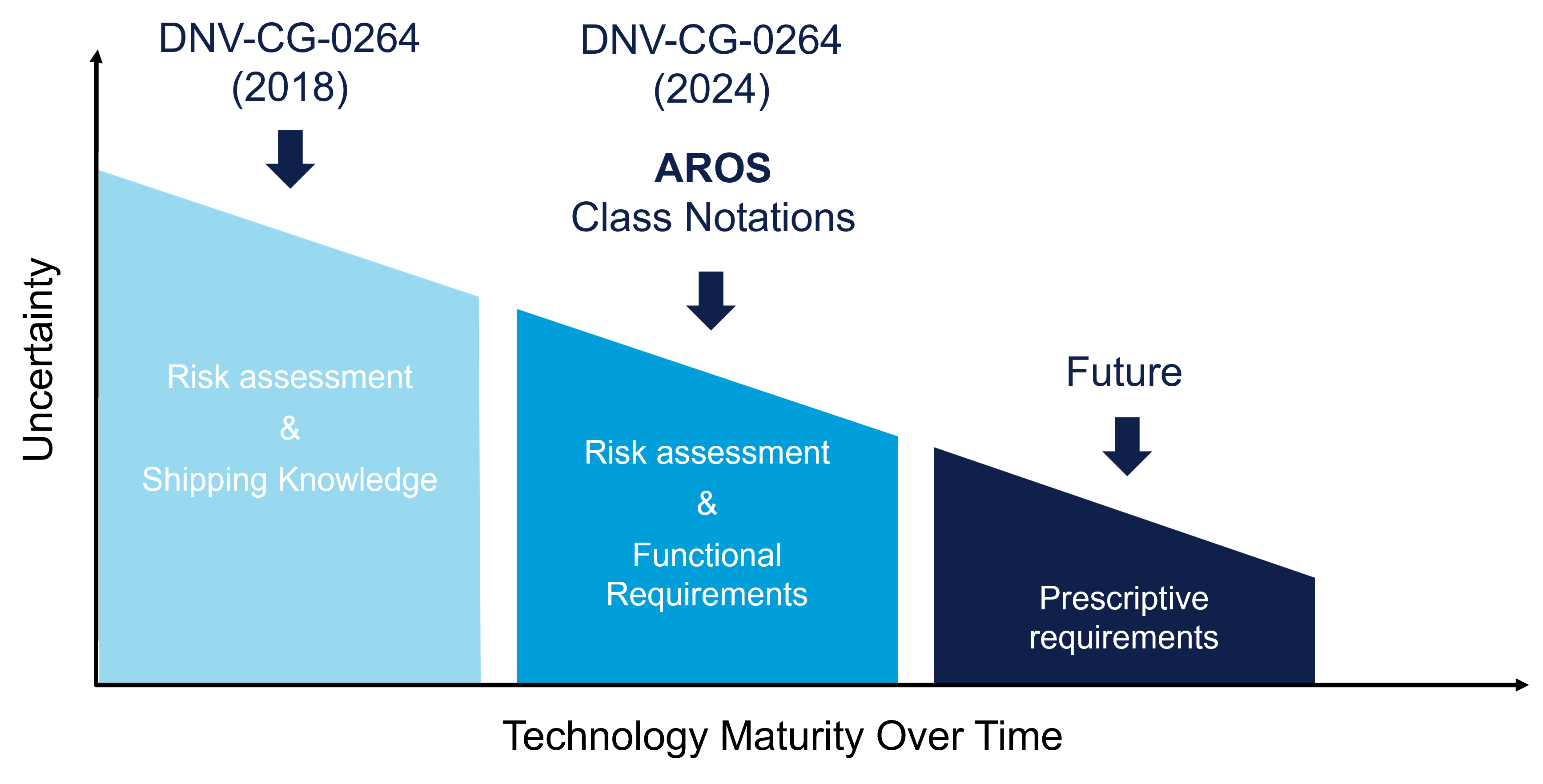The rise of automous shipping
Autonomous shipping – ranging from remote control operation to fully unmanned vessels – represents a significant evolution in the maritime industry. ‘Autoremote’ is the adjective coined by DNV to include all possibilities within the autonomous and remote operation spectrum.
It promises a wide range of benefits, including improved safety, optimised logistics chains, improved cargo capacity due to reductions in crew, increased fuel efficiency, reduced emissions, and reduced operational and maintenance costs. Autonomous shipping vessels also stand to revolutionize the maritime sector, offering groundbreaking advantages in efficiency and sustainability.
DNV anticipates growing prevalence of autonomous shipping, both in newbuilds and with added autonomous functionality to existing vessels. This transition is expected to occur gradually, evolving in a stepwise manner over the coming years.
Different aspects of autonomous shipping
The term "autonomous ship" in maritime industry can be defined by three main aspects – location of control, degree of system independence, and human involvement. Based on this, autonomous shipping can be separated into four broad categories:
- Remote control: The activities of the onboard operation are transferred to a location other than the vessel. The operator is responsible for the vessel’s function and does not rely on the use of an autonomous system for decision making or decision support.
- Decision support: When conventional vessels are equipped with a decision support system, it functions as an advisory system, like a co-pilot. The system acquires real-time data, analyzes information, plans actions, and advises the operator on potential courses of action. This setup may offer benefits such as improved operational predictability, enhanced safety, reduced crew workload, and lower maintenance costs, potentially leading to increased fuel efficiency and reduced emissions.
- Supervised autonomy: Similar to a decision support system, but with the distinction that the system is capable of autonomous action without waiting for acknowledgment. Human operators stay informed and can intervene if needed. Key autonomous functions include safety measures like auto-lookout and collision avoidance, as well as operational optimizations like remote navigation and monitoring.
- Full autonomy: This has the same goal as the supervised autonomy system with even more benefits. However, in this case, the vessel actsindependently, and the human operator is only involved in exceptional circumstances.
Towards full autonomy: Current landscape, regulatory developments, and prospects
Among the different aspects of autonomous shipping, decision support systems are most prevalent on the market today. In the longer run autonomy is expected to develop more towards unmanned, fully autonomous vessels as technologies, regulations and norms evolve. These advancements rely heavily on autonomous vessel technology, which underpins both the hardware and software enabling this shift. Crew on these vessels will be minimal and control will be carried out from centralized, onshore Remote Operations Centres (ROCs).

AROS class notations as part of the evolution of MASS
Challenges in autonomous shipping
Before autonomous and remotely operated ships can be effectively deployed, numerous challenges must be addressed, spanning from ensuring the reliability of onboard machinery, to guaranteeing the stability and cybersecurity of essential software, and finally, navigating the complex landscape of national and international rules and regulations.
DNV is actively collaborating with stakeholders in this emerging field to build a robust framework for how autoremote vessels can achieve equivalent or higher safety compared to conventional vessels.This framework supports equipment manufacturers and ship owners to ensure the safe integration of their equipment and vessels into the market.
Check Autoremote Systems for more details about the process to approve systems and equipment intended to implement autonomy and remote control. For more details about the evaluation and approval of an autonomous or remotely operated vessels, check and Autoremote Vessels and AROS Class Notation.
Related links
Digitalization in shipping: Advancements in autonomy and remote operation
Watch the on-demand webinar on advancements in autonomy and remote operation
Ensuring the safety of autonomous shipping
Read our article on the development of the Autonomous and Remotely Operated Ships (AROS) notation for maintaining safety standards.
News
Explore the latest news in Autonomous Shipping
DNV launches class notations for safe development of autonomous shipping technologies
DNV has launched a new family of class notations, Autonomous and Remotely Operated Ships (AROS), providing a framework for how autoremote vessels can achieve equivalent or higher safety compared to conventional vessels.
DNV and Brinav signs MOU further broadening their autonomy collaboration
DNV and Navigation Brilliance (Brinav), signed a memorandum of understanding on autonomous collaboration.
SMM 2024: DNV celebrates advances in ship autonomy
At SMM 2024, DNV celebrated three advances in the ongoing development and deployment of autonomous technologies in shipping.
Approval in Principle for Kongsberg Maritime Chief to Shore
In June 2024, Kongsberg Maritime has received Approval in Principle from classification society DNV to enable a key role to be transferred from a ship to a shore-based control centre.
Remote Operations Centre collaboration
In October 2023, DNV and Samsung Heavy Industries’ signed an MoU for the collaboration to drive innovation and redefine the future of marine transportation.
Related services
Maritime Research on Ship Autonomy
Check out how DNV’s R&D team are working on developing framework and tools for autonomous ship technology assessment.
Maritime Cyber Security
Explore the importance of cyber security for different stakeholders in the maritime industry

